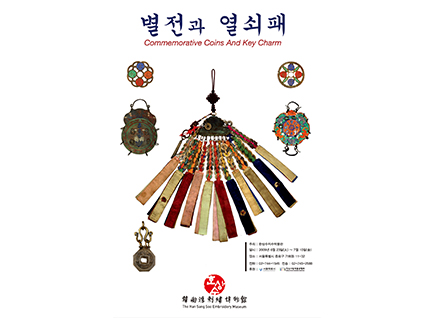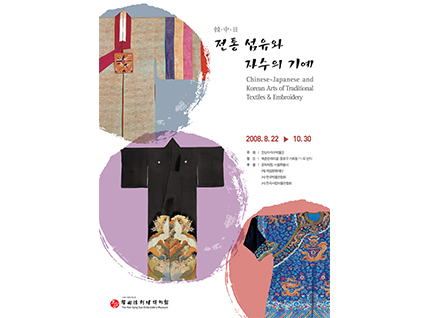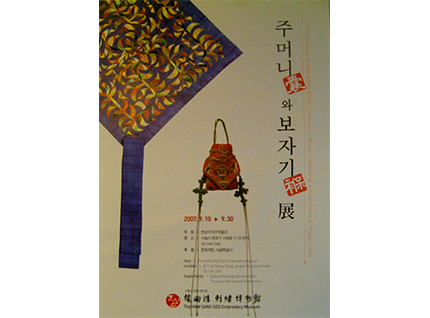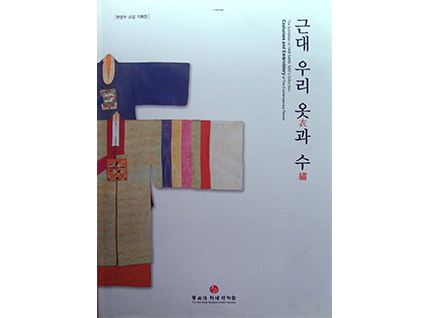About the Museum
Han Sangsoo Embroidery Museum, opened at Bukchon Hanok Village as a private museum (registration no. 20) in 2005, is an art museum specialized in preserving, collecting, exhibiting, and studying the artworks and related domestic and foreign materials of the master artisan Han Sangsoo (the first holder of Jasujang; National Intangible Cultural Heritage No. 80) in accordance with the systemic administration of the International Council of Museums (ICOM).
The museum spotlights the history of embroidery that has been developed with the beginning of human civilization, connects and exchanges embroidery cultural heritage of various ethnic groups and societies, and helps future generations value embroidery cultural heritage. By doing so, the museum fosters the awareness of history and culture in the community and plays a role in the development of local art and culture.
The museum plans special exhibitions for various themes every year to promote the proper succession and creative development of embroidery, and to contribute to the leisure and healthy lives of the people through the high-quality appreciation of embroidery art. The affiliated institutions restore and research ancient embroidery, textiles, and clothing and train professionals thereof. They also support the development of contemporary cultural industries as well as display and interact with museums and research institutions in Korea and abroad.
SURIM HAN SANGSOO (繡林 韓尙洙, 1932 – 2016)
Han Sangsoo is a master embroiderer who promoted ancient Korean embroidery as an art and
craft by artisans and established a field of research on it.
She restored the historical artworks to pass them to future generations.
Since 1952, when she was a student at Seoul National University of Literature, Han Sangsoo
has demonstrated her creativity by being accepted by the National Art Exhibition of The
Republic of Korea 4 times and giving 10 private exhibitions.
In 1963, she established the "Surimwon - Handicraft Academy of Korea" to practice embroidery
crafts under the slogan of “a person should learn at least one skill (一人一技) and produced
related experts as a certified vocational training center by the labor office.
Collecting Korean embroidery artifacts scattered amid the wave of modern industrialization
in the early 1970s, Han Sangsoo studied the techniques of ancient embroidery and published
30 solo exhibitions and research works, thereby developing a new genre called "traditional
embroidery." At that time, she was registered with the Cultural Heritage Administration as
the first holder of Jasujang (National Intangible Cultural Heritage No.
80) in 1984 for her work in restoring Korean royal embroidery and Buddhist embroidery, which
had already lost the tradition of the Joseon period.
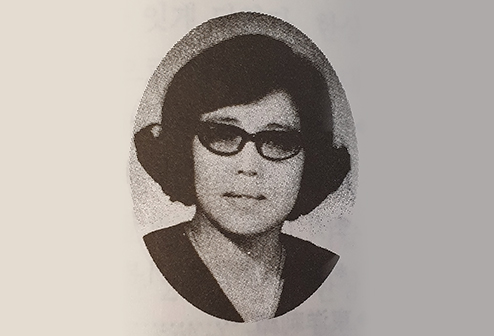
As examples of Korean traditional embroidery techniques, there are ‘Saseul-su (chain
stitch)’ of the chain-looking embroidery pattern from the prehistoric period, ‘Yieum
mekkum-su (filling of outline stitch)’ of the early 7th century Baekje, ‘Jinggeom-su
(couching stitch)’ of pattern stitched with gold and silver threads at regular intervals,
‘Gori-su’ of the10th century from Goryeo which is named for its round ring-shape, and
‘Jari-su (mat stitch)’ resembling the pattern of a straw mat which can be seen in the
handicraft of the Anju area embroidered by an artisan during Joseon dynasty. Besides, there
are more traditional techniques such as ‘neukkim-su’, ‘Segim-su (appliqué)’, ‘Ollim-su (the
stitch for decoration with beads and pearls)’.
In addition to researching and restoring ancient embroidery, Han Sangsoo has been constantly
trying new embroidery styles combined with other contemporary art and crafts, thereby
developing "Saui (寫意: a style of freehand sketch, or “sketching thoughts”) Embroidery,"
"Bujo (浮彫: relief) Embroidery," and "Jiksu (織繡: weave and embroider)." She also released a
variety of new works that transcended genres. The embroideries of Han Sangsoo were presented
at the "Silk: Royalty and Dreamer" exhibition (held in Washington on June 27, 2002), and the
Washington Post commented that her works are elaborate and spectacular.
One of the major works by Han Sangsoo is the Cheonsuguksujang (天壽國繡帳, Tenjukoku Shūchō:
Japanese national treasure assumed to be produced by ancient Korean artisans) embroidered on
the jasaek-neungmunlaji (紫色 菱紋羅地: a purple lozenge 4-end complex gauze; restored and
produced by Dr. Kim Youngran) after 30 years of research. Her efforts and dedication to
Korean embroidery also can be found in her other major embroidery works such as the Goryeo
Suwolgwanumdo (水月觀音圖: Painting of Avalokitesvara Bodhisattva), Gungjung-Bongwhangdo (宮中 鳳凰圖:
Court Painting of Phoenixes), Chaekgeori (Korean still-life paintings), Jiksu jeogui (織繡 翟衣:
woven and embroidered empress’ ceremonial attire), Hwarot (Korean traditional bridal robe)
with Bugeum Jaso, Gwaebul (掛佛: Large outdoor ceremonial Buddha scroll), and the works in the
early sixties including bipa (Korean musical instrument of pear-shaped lute), ilsaeng (一生:
the lifetime), and hwanhwui (歡喜: the joy). Moreover, she wrote books including Gibon Jasu
(Basic Embroidery, 1972), Gibon Inhyeong (Basic Doll, 1972), Ijo Jasu (Embroidery of Joseon
Dynasty, 1974), Hyungbae (Embroidery of Official Uniforms 1976), and Subul (Embroidery of
Buddha, 1983). Such resources and her research progress can be found in the exhibition art
brochures (published twice a year) of the Han Sang Soo Embroidery Museum.
Han Sangsoo's spirit,
The Beauty of Korean Embroidery Arts
Embroidery uses thread and needles and applies various techniques to create a form in which
shapes, colors, and textures are alive. Embroidery crafts, which stitch along the shape of
the design with colored threads on the knitted or woven fabrics, show remarkable artistry
due to their features such as the use of simple tools, unlimited selection of materials, and
free expression of patterns and colors.
The history of Korean embroidery begins in prehistoric times when various materials such as
shells, beads, leather, and stem fibers were used to decorate the abundant embroidery
pattern. Thin bone needles of 45,000 years ago prove this fact, and the 'olim-su (3D
stitch)’ of jade beads in the Neolithic and the 'saseul-su (chain stitch)’ with silk thread
in the Gojoseon period show that Korean embroidery is beautiful and delicate craft art with
the artistic and cultural sentiment that has been cultivated for thousands of history.
The ancient artisans explored the creation of an
undulating grainline of an embroidery pattern showing lustrousness through the arduous work
of forming the pattern with countless repetitions of embroidering a single thread. In this
sense, such colorful embroidery works are the embodiment of perseverance refined beyond its
limits and are a spirit of free liberation.
In traditional society, embroidery was considered one of women's training and virtues and
had an artistic status comparable to painting and calligraphy. There are historical
embroidery works such as "Jeoninhyeonwanghujakjasu/Suhainmuldo (傳仁獻王后作刺繡/樹下人物圖: The painting
of people under the tree embroidered by Queen Inhyeon)" of the collection of the National
Museum of Korea or the "Cheonsuguksujang (天壽國繡帳, Tenjukoku Shūchō)" of Japanese National
Treasure, which was produced by the participation of artisans from Goguryeo, Baekje, and
Silla. Just as these great works are beloved by the public timelessly, we also express
admiration for the works of Master Artisan Han Sangsoo. The fact that embroidery is
collected both as a daily craft and as an ornamental art shows that embroidery contains a
deep artistic sentiment accumulated in its long history.
Embroidery has a unique coloring by which threads wrap each other with their own lights instead of painting or dyeing the textile, thereby expressing a deep aesthetic and artistic sentiment together with the warm humanistic lyrical beauty of the embroidery pattern. In addition, being immersed in an embroidery frame, the frame becomes a space to be faced with the inner self. Embroidery seems to be a gift of silence that brings the mind together with the time of accumulation of a thread and a stitch so that the mind becomes quiet and the joy of reflection approaches. Therefore, it is expected that the development of Korean embroidery will be endless if we continue the creation of freedom and proper inheritance from a contemporary standpoint.
-An excerpt of “Esthetics of Embroidery (Kim Youngran, 2016)”
Affiliated Institutions
SURIMWON Korean Embroidery Institute
Starting with the Korea Institute of Handicraft in 1963, SURIMWON Korean Embroidery Institute was established to train successors and to publish, exhibit, and distribute works. In particular, aiming to shed light on the history of Korean embroidery and establish it as a field of practical crafts, the institute finds and collects the original form of Korean embroidery to classify embroidery-related resources and restore traditional techniques.
IATD Institute of Ancient Textiles & Fashion Science Technology Development
IATD was established in 1996 as the Institute for the History of Ancient Textile Science
and Technology to reveal and hand down ancient craft techniques related to textiles,
knitting, embroidery, and block printing. Up until now, they have restored ancient
fabrics such as "gyeonggeum", "sora", "mundan", "Jikgeumdan", "Geumjik", and "munla".
The institute is focusing on the preservation and management of textile-related
artifacts and restoration production along with the exploration of archaeological
artifacts, research, and the creation of new designs.
SURIMWON Publishing House
Specialized publishing for arts and archaeology, museum studies, biographical books and exhibitions. The trials of "Basic Doll", "Basic Embroidery", " Embroidery of the Chosun Dynasty era ", " Buddhist embroidery ", and "The Rank Bage", and "Traditional Techniques and Aesthetic of Interlacing and Woven, Embroidered Products in China" are published.


